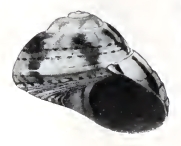Biology:Gibbula medusa
| Gibbula medusa | |
|---|---|

| |
| Apertural view of a shell of Gibbula medusa | |
| Scientific classification | |
| Domain: | Eukaryota |
| Kingdom: | Animalia |
| Phylum: | Mollusca |
| Class: | Gastropoda |
| Subclass: | Vetigastropoda |
| Order: | Trochida |
| Superfamily: | Trochoidea |
| Family: | Trochidae |
| Genus: | Gibbula |
| Species: | G. medusa
|
| Binomial name | |
| Gibbula medusa Bartsch, 1915
| |
Gibbula medusa is a species of sea snail, a marine gastropod mollusk in the family Trochidae, the top snails.[1]
In 1963 K.H. Barnard considered this name a synonym and a juvenile form of Gibbula tryoni Pilsbry, 1889 [2]
Description
The height of the shell attains 3.5 mm, its diameter 5 mm. The shell has a depressed conic shape. The nuclear whorls are white. The postnuclear whorls are marked with broad axial bands of brown which may extend entirely across the whorls, or may be interrupted in the middle. These bands of brown are separated by spaces of a light sage green, which are about as wide as the brown bands on the posterior half of the whorls between the sutures. The green area fading to yellow anteriorly. These light areas are speckled with small dots of chestnut and clouded in places with pale brown. The base of the shell is pale green, profusely spotted with dots and blotches of red. The 2¼ nuclear whorls are depressed helicoid. The postnuclear whorls are evenly rounded, marked with two, broad, spiral bands, which extend over the anterior half of the whorls between the sutures, where they appear as two turns of a bandage. The periphery of the body whorl is marked by a moderately strong spiral keel which renders it angulated. The sutures are feebly constricted. The base of the shell is short, well rounded, and broadly umbilicated. It is marked by seven broad low bands which grow successively wider from the umbilical edge toward the periphery. These bands appear as a series of turns of a bandage. The umbilicus lacks any spiral sculpture. The entire surface of spire and base is marked with faint retractive lines of growth. The oval aperture is very oblique. The outer and basal lips are thin, showing the external markings within. The inner lip is quite thick, evenly curved. The parietal wall is glazed with a very thin callus.[3]
Distribution
This marine species occurs off Cape of Good Hope, South Africa
References
- ↑ Smithsonian Institution: Gibbula medusa
- ↑ Contributions to the knowledge of South African marine Mollusca; Annals of The South African Museum vol. 47; 1963
- ↑ P. Bartsch (1915), Report on the Turton collection of South African marine mollusks, with additional notes on other South African shells contained in the United States National Museum; Bulletin of the United States National Museum v. 91 (1915)
External links
Wikidata ☰ Q16982308 entry

